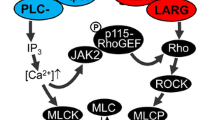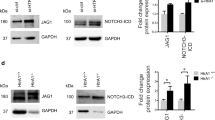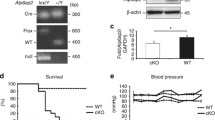Abstract
Gh, a high molecular weight GTP-binding protein that couples α1-adrenoceptors in heart and liver to phosphatidylinositol (Ptdlns)-specific phospholipase C (PLC), has recently been shown to be a tissue transglutaminase type 11. Transglutaminases have been suggested to play a role in the maintenance of blood vessel structure, and therefore it is possible that changes in their expression may accompany pathological states which involve phenotypic modulation of smooth muscle. Hence, we investigated the expression of Gh during differentiation of rat aortic smooth muscle cells in culture. Gh content was reduced markedly in cultured smooth muscle cells compared to freshly isolated cells as determined by Western blotting using a Gh-specific monoclonal antibody. In contrast, the level of Gq, a heterotrimeric G-protein that couples α1-adrenoceptors to PLC, was maintained throughout the culture period. These findings indicate that changes in G, expression accompany phenotypic modulation of vascular smooth muscle cells. These changes in Gh protein expression may be important in the altered responsiveness of vessels in pathological disease states.
Similar content being viewed by others
References
Eschenhagen T: G Proteins and the heart. Cell Biol Int 17: 723–749, 1993
Wu D, Katz A, Lee C-H, Simon MI: Activation of phospholipase C by α1-adrenergic receptors is mediated by the a subunits of Gq family. J Biol Chem 267: 25798–25802, 1992
Im M-J, Graham RM: A novel guanine nucleotide-binding protein coupled to the α1-adrenergic receptor. I. Identification by photolabeling of membrane and ternary complex preparations. J Biol Chem 265: 18944–18951, 1990
Nakaoka H, Perez DM, Baek KJ, Das T, Husain A, Misono K, Im MJ, Graham RM: Gh: A GTP-binding protein with transglutaminase activity and receptor signalling function. Science 264: 1593–1596, 1994
Vincan E, Neylon CB, Graham RM, Woodcock EA: Isolation of neonatal cardiomyocytes reduces the expression of the GTP-binding protein, Gh. J Mol Cell Cardiol, 27: 2393–2396, 1995
Bobik A, Campbell JH: Vascular derived growth factors: cell biology, pathophysiology, and pharmacology. Pharm Rev 45: 1–42, 1993
Masuo M, Toyo-oka T, Shin WS, Sugimoto T: Growth-dependent alterations in intracellular Ca2+-handling mechanisms of vascular smooth muscle cells. PDGF negatively regulates functional expression of voltage-dependent, IP3 -mediated, and Ca2+-induced Cat. release channels. Circ Res 69: 1327–1339, 1991
Thomazy V, Fesus L. Differential expression of tissue transglutaminase in human cells. An immunohistochemical study. Cell Tiss Res 255: 215–224, 1989
Greenberg CS, Birokbichler PJ, Rice RH. Transglutaminases: multifunctional cross-linking enzymes that stabilize tissues. FASEB J 5: 3071–3077, 1991
Neylon CB, Avdonin PV, Dilley RJ, Larsen MA, Tkachuk VA, Bobik A: Different electrical responses to vasoactive agonists in morphologically distinct smooth muscle cell types. Circ Res 75: 733–741, 1994
Neylon CB, Nickashin A, Little PJ, Tkachuk VA, Bobik A: Thrombininduced Ca2+ mobilization in vascular smooth muscle utilizes a slowly ribosylating pertussis toxin-senstitive G protein. Evidence for the involvement of a G protein in inositol trisphosphate-dependent Ca2+ release. J Biol Chem 267: 7295–7302, 1992
Bradford MM: A rapid and sensitive method for the quantitation of microgram quantities of protein utilizing the principle of proteindye binding. Anal Biochem 72: 248–254, 1976
Woodcock EA, Tanner JK, Fullerton M, Kuraja IJ: Different pathways of inositol phosphate metabolism in intact neonatal rat hearts and isolated cardiomyocytes. Biochem J 281: 683–688, 1992
Woodcock EA, Suss MB, Anderson KE: Inositol phosphate release and metabolism in rat left atria. Circ Res 76: 252–260, 1995
Rossier MF, Capponi AM, Vallotton MB: Metabolism of inositol 1,4,5-trisphosphate in permeabilized rat aortic smooth-muscle cells. Dependence on calcium concentration. Biochem J 245: 305–307, 1987
Pijuan V, Sukholutskaya I, Kerrick WG, Lam M, van Breemen C, Litosch I: Rapid stimulation of Ins(1,4,5)P 3 production in rat aorta by NE: correlation with contractile state. Am J Physiol 264: H126-H132, 1993
Author information
Authors and Affiliations
Rights and permissions
About this article
Cite this article
Vincan, E., Neylon, C.B., Jacobsen, A.N. et al. Reduction in Gh protein expression is associated with cytodifferentiation of vascular smooth muscle cells. Mol Cell Biochem 157, 107–110 (1996). https://doi.org/10.1007/BF00227887
Issue Date:
DOI: https://doi.org/10.1007/BF00227887




